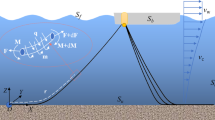Abstract
Hydrodynamic performance of an ultra deep turret-moored Floating Liquefied Natural Gas (FLNG) system is investigated. Hydrodynamic modeling of a turret-moored FLNG system, in consideration of the coupling effects of the vessel and its mooring lines, has been addressed in details. Based on the boundary element method, a 3-D panel model of the FLNG vessel and the related free water surface model are established, and the first-order and second-order mean-drift wave loads and other hydrodynamic coefficients are calculated. A systematic model test program consisting of the white noise wave test, offset test and irregular wave test combined with current and wind, etc. is performed to verify the numerical model. Owing to the depth limit of the water basin, the model test is carried out for the hydrodynamics of the FLNG coupled with only the truncated mooring system. The numerical simulation model features well the hydrodynamic performance of the FLNG system obtained from the model tests. The hydrodynamic characteristics presented in both the numerical simulations and the physical model tests would serve as the guidance for the ongoing project of FLNG system.
Similar content being viewed by others
References
Bompais, X., Le Boulluec, M., Dekint, F., Marin, S. and Molin, B., 1994. Slow drift motion: practical estimation of mooring line damping, Proc. 13th Int. Conf. on Offshore, Mechanics and Arctic Engineering, 383–391.
Garrett, D. L., Gordon, R. B. and Chappell, J. F., 2002. Mooring-and riser-induced damping in fatigue sea states, Proc. 21st Int. Conf. on Offshore, Mechanics and Arctic Engineering, 793–799.
Gervois, G., Daniel, L., Jestin, N., Kyriacou, A. and Saipem, S. A., 2005. Floating LNG -A look at export and import terminals, Proceedings of the 2005 Offshore Technology Conference (OTC), Houston, U.S.A., OTC17547.
Heurtier, J. M., Le Buhan, P., Fontaine, E., Le Cunff, C., Biolley, F. and Berhault, C., 2001. Coupled dynamic response of moored FPSO with risers, Proc. of the 11th ISOPE Conf., 319–326.
Low, Y. M. and Langley, R.S., 2007. A comparison of methods for the coupled analysis of floating structures, Proc. 26th Int.Conf. on Offshore, Mechanics and Arctic Engineering, San Diego, USA, OMAE 2007-29229.
Ormberg, H. and Larsen, K., 1998. Coupled analysis of floater motion and mooring dynamics for a turret-moored ship, Appl. Ocean Res., 20(1–2): 55–67.
Rho, J-B., Korobkin, A. A., Jung, J-J., Shin, H-S. and Lee, W-S., 2007. Coupled analysis of deepwater floating system including VIV in time domain, Proc. 26th Int. Conf. on Offshore, Mechanics and Arctic Engineering, San Diego, USA, OMAE 2007-29523.
Stansberg, C. T., Yttervik, R. and Nielsen, F. G., 1998. Wave drift forces and response in storms waves, Proc., PRADS’98, The Hague, The Netherlands, 1005–1012.
Tahar, A., Ran, Z. and Kim, M. H., 2002. Hull/mooring/riser coupled spar motion analysis with buoyancy-can effect, Proc. 12th Int. Offshore Polar Eng. Conf. (ISOPE), Kitakyushu, Japan, 223–230.
Webster, W., 1995. Mooring-induced damping, Ocean Eng., 22(6): 571–591.
White, J. and Longley, H., 2009. FLNG technology shows promise for stranded gas fields, Offshore, 2009, 78–79.
Wichers, J. E. W. and Devlin, P. V., 2001. Effect of coupling of mooring lines and risers on the design values for a turret moored FPSO in deep water of the Gulf of Mexico, Proc. 11th Int. Offshore Polar Eng. Conf. (ISOPE), Stavanger, Norway, 480–487.
Wichers, J. E. W. and Huijsmans, R. H. M., 1990. The contribution of hydrodynamic damping induced by mooring chains on low-frequency vessel motions, Offshore Technology Conference, Houston, Texas, USA, Paper No. 6218.
Wichers, J. E. W. and Ji, C. Q., 2000. On the coupling term in the low-frequency viscous reaction forces of moored tankers in deep water, Offshore Technology Conference, Houston, Texas, USA, OTC l2086.
Zhang, X. Y. and Zou, J., 2002. Coupled effects of risers/supporting guide frames on spar responses, Proc. 12th Int. Offshore Polar Eng. Conf. (ISOPE), Kitakyushu, Japan, 231–236.
Author information
Authors and Affiliations
Corresponding author
Additional information
This work was financially supported by the Science Foundation of the Science and Technology Commission of Shanghai Municipality (Grant No. 11ZR1417800), and also the National Natural Science Foundation of China (Grant No. 50879045).
Rights and permissions
About this article
Cite this article
Zhao, Wh., Yang, Jm., Hu, Zq. et al. Investigation on the hydrodynamic performance of an ultra deep turret-moored FLNG system. China Ocean Eng 26, 77–93 (2012). https://doi.org/10.1007/s13344-012-0006-4
Received:
Revised:
Accepted:
Published:
Issue Date:
DOI: https://doi.org/10.1007/s13344-012-0006-4




